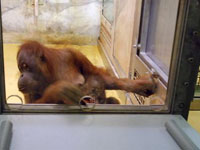德国莱比锡的马普研究所人类进化学协会(Max Planck Institute for Evolutionary Anthropology)约瑟普柯博士(Josep Call)的一项研究显示,猩猩、黑猩猩、倭黑猩猩和大猩猩等类人猿,都能察觉选择中的错误。这项研究结果已经发表在了在线期刊《动物认知》(Animal Cognition)中。
这项研究分为三个系列实验,来自德国沃尔夫岗科勒研究中心动物园的七只大猩猩(gorilla)、八只黑猩猩(chimpanzee)、四只倭黑猩猩 (bonobo)和七只长臂无尾巨猴(orangutan)参与其中。研究人员给它们两根空心管子,其中一根中装有食物作为诱饵,另一根则没有。然后,研究人员观察记录了它们找到“奖赏”的全过程。
在第一个实验中,类人猿不会看到这些诱饵,但是研究人员会通过摇动管子来发出声音讯号,以帮助猩猩确定目标的位置。柯博士旨在通过这项实验,来测试类人猿在没有可视信号时,是否会通过听觉来降低对视觉的依赖。
第二个实验中,研究人员首先会让猩猩看到食物藏匿的位置,然后隔上一段时间,再让猩猩开始寻找,每次实验的间隔时间不断延长。这个实验的目的在于了解忘记地点是否会对类人猿的寻找增加难度。
最后一个实验是比较当食物质量改变时,类人猿对可见的诱饵和隐藏的诱饵状况的不同反应。作者猜测,不论是否真的确定食物的位置,类人猿都会在冒险获得更好的食物时斟酌再三。
尽管在研究人员的提示下,类人猿们都非常准确地找到了“奖赏”,但柯博士发现,它们更倾向于在选择在冒险之前先检查管子的内部是否有它们想要的东西,或者在受到引诱后等待更长的时间再决定出手获得食物。相反,当类人猿收到有关食物位置的听觉信号时,它们会更迅速地作出决定。柯博士的三个实验结果显示,类人猿能够在选择时意识到自己的决定可能是错误的。
柯博士总结说:“目前的研究结果主要基于三个方面:观察管子内部要付出的代价,奖品的价值和信息的形态。这三方面的结合形成了一个处理信息的系统,这些信息通常都是复杂的,多变的,受控制的。这三个特点都属于元认知(即人类对于自己认知活动的认知)的范畴。这些发现表示非人类的动物也拥有元认知的能力。”
推荐原文出处:
Animal Cognition doi:10.1007/s10071-010-0317-x
Do apes know that they could be wrong?
Josep Call
Max Planck Institute for Evolutionary Anthropology, Deutscher Platz 6, 04103 Leipzig, Germany
When confronted with uncertain or incomplete information in decision-making situations, monkeys and apes opt for either escaping the situation or seeking additional information. These responses have been interpreted as evidence of metacognitive abilities. However, this interpretation has been challenged. On the one hand, studies using the information-seeking paradigm have been criticized because subjects may simply engage in a search for information routine (e.g., search until spot the reward) without any metacognitive involvement. On the other hand, studies using the escape response paradigm have been criticized because subjects may not recognize their own state of uncertainty but have learned to use the escape response in the presence of certain stimuli configurations that create uncertainty. The current study attempted to address these two criticisms by presenting great apes (seven gorillas, eight chimpanzees, four bonobos, seven orangutans) with a seeking information task whose basic procedure consisted of presenting two hollow tubes, baiting one of them and letting subjects choose. Conditions varied depending on whether subjects had visual access to the baiting, the cost associated with seeking information, the time interval between baiting and choosing, the food quality and the additional information offered regarding the food’s location. Although subjects showed a high retrieval accuracy when they had witnessed the baiting, they were more likely to check inside the tube before choosing when high stakes were involved (Experiment 3) or after a longer period of time had elapsed between the baiting and the retrieval of the reward (Experiment 2). In contrast, providing subjects with indirect auditory information about the food’s location or increasing the cost of checking reduced checking before choosing (Experiment 1). Taken together, these findings suggest that subjects knew that they could be wrong when choosing.








